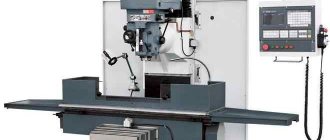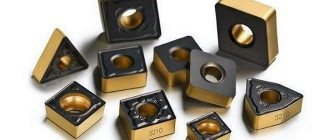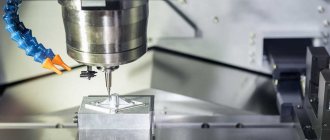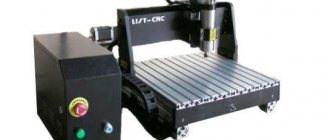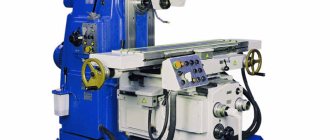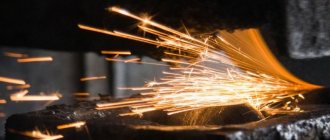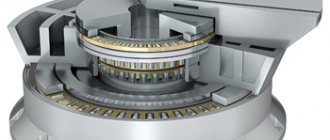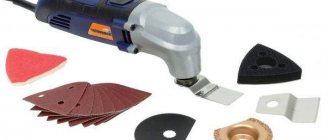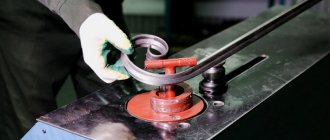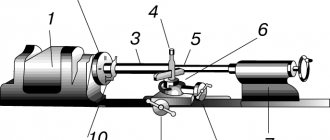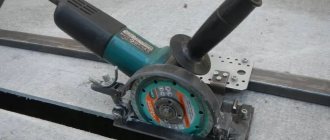A copy milling machine is used to produce parts of complex shapes. Using such equipment, molds, propeller blades, as well as metal castings and bending dies are made. The copying machine is developed on the basis of milling machines. If you need to copy a part made of wood or metal at enterprises, in small workshops and in production, copy-milling equipment is used. The main purpose of the units is to create parts that are as identical as possible to the original sample.
In large manufacturing enterprises and small workshops, there is often a need to create several identical parts according to one sample. To do this, they use equipment of this type, which makes it possible to produce identical parts in large batches, and in quality that is not inferior to the original sample.
Machine design
Copy milling machines are used to process workpieces by milling two types:
1 – planar – processing of profiles;
2 – volumetric – processing of surfaces with relief.
Milling cutters are used as a working tool, which, when processing a workpiece, exactly repeat the contour of the original part, repeating the movements of the copier. The working tool is driven, in the case of manually operated machines, using pneumatic, hydraulic and mechanical elements. These elements are necessary to generate the force from the copier to the working tool of the machine.
A flat contour or spatial model, contour drawings or a reference part is used as a template. The element that reads the shape and dimensions of the model is called a copying finger, roller, probe or photocell. The reference part and the workpiece being processed are placed on a rotating work table of a drilling and milling machine. The reference part is made of aluminum. Other metal, plastic or wood are also used.
The working body of the machine is driven by a screw, solenoid, spool valve, electromagnetic clutch or differential. In addition, special relays are used for amplification, which can be electro-optical, hydraulic or electromagnetic.
The actuator circuit of any model of drilling and milling machine consists of a hydraulic cylinder and an electric motor.
Some machine models are equipped with a pantograph - a device that ensures copying of a part to a given scale. Structurally, the unit consists of a guide pin, an axis, a tool spindle and an axis of rotation. The guide pin and spindle are mounted on the same rail. The copying scale is determined by the ratio of the arms of a given slatted frame.
The process of copying a part occurs as follows:
— the finger moves along the contour of the reference part and sets the rack in motion, which in turn rotates on an axis;
- on the other side of the rack, the spindle makes similar movements, thereby processing the workpiece.
Equipment classification
Depending on the type of drive used in the design, copy-milling equipment is divided into the following types:
- machines with a pantograph make it possible to process workpieces in two or three dimensions;
- machines with a copier, which is mounted on a rotary rack moving in a vertical plane;
- machines with multiple spindles, equipped with round or rectangular rotary tables;
- machines, the feed on which is ensured by mechanical, electrical, hydraulic devices;
- photocopying equipment.
In addition to this classification, equipment is divided according to the method of fixing the workpiece, as well as the degree of automation.
- Handheld or tabletop. In this case, the workpiece is fixed mechanically. Such machines allow you to drill holes of various shapes in accordance with the template.
- Standard automatic machines. The workpiece is fixed using pneumatic clamps. Such machines are used for processing aluminum workpieces.
- Stationary automatic machines with pneumatic clamps. This equipment is equipped with a head with three spindles. The machines make it possible to drill triple holes.
- Carousel type machines. Designed for wood processing in carpentry. Using such a machine, they make legs, backs, armrests and other curved parts of chairs. Productivity is more than 1000 parts per shift. It is also used in the manufacture of panels for doors and facades.
- Longitudinal milling copy machines. The machine is equipped with a carriage that moves between the milling and grinding elements.
Basics of the Milling Process
In almost all large industrial production and small workshops you can find milling machines. After all, milling is the most popular method of mechanical processing of products. Milling devices are used to perform rough, semi-finishing and finishing machining of workpieces made of wood, ferrous and non-ferrous metals, as well as plastic. Modern machines are capable of quickly and accurately processing products of not only simple, but also the most complex shapes.
Milling machines are divided into two types:
- General purpose machines.
- Specialized equipment.
The specialized equipment includes the copy milling cutters in question. They allow you to make copies of objects and work with both flat and three-dimensional shapes. Moreover, these devices can help to engrave, apply ornaments, various inscriptions, and create various patterns on edges that are located in different planes.
There are two milling methods:
- Counter, in which the tool is fed and rotated in different directions.
- Incidental. In this case, the feed and rotation of the tool occur in different directions.
The cutting blade of cutters of such machines can be made of a variety of materials, which allows you to successfully switch from processing wooden products to hard metals and even natural or artificial stones.
Application of copy milling machines
Copy-milling machines are designed to perform copying work in volume and on a plane. They are used when working with three-dimensional models and corresponding copiers, for engraving various shaped profiles, patterns, ornaments and inscriptions. The main advantage of the equipment is the production of complex patterns.
The machines are capable of processing steel, cast iron, and non-ferrous metals. High-speed and carbide tools are used for processing in large- and small-scale production. Copy-milling machines are used to produce propellers of ships, blades of turbojet engines and steam turbines, impellers of hydraulic turbines, cutting and forging dies, press and casting molds, stamps, molds, metal models and blanks.
The units are also used for drilling holes for handles, locks, latches, and metal hinges. In addition, it is possible to produce frames for mirrors and channels on plastic and aluminum profiles.
A copy-milling machine is used for milling curved parts. The use of templates eliminates the influence of the human factor. Moreover, all finished products have the same shape and parameters.
To accurately replicate a part, a pantograph is installed on a copy-milling machine. Its function is to accurately transmit the movement of the copy head along the profile of the cutting device. The use of this element makes it possible to produce several identical parts with high precision, which will be the same as the original sample.
Selection of design and materials
To create a machine with your own hands, you should prefer a simplified creation scheme. But this only applies to models for domestic use. Most often they are used to create artistic components or decorative elements. Such products are created with a high permissible error.
The main working element is to choose a lever design. The purpose of its supporting part is to implement the milling operation. The processing tool and copying unit are mounted on a swinging rod. It must have a plane displacement function in order to process parts of different sizes.
Experts advise following the following recommendations during the manufacturing process of a copying machine:
- the work table must be equipped with mechanisms for fixing the workpiece and the original figure. Most often, a small vice is used for this purpose.
- the swinging frame must be made of square pipes. This configuration will help you ease the process of mounting it on the support stand. Bearings can become hinges. This way you will reduce the likelihood of jerking during the displacement process
- For processing, you should use a factory manual milling cutter. To fix it on the frame, you need to use a rigid clamp with the ability to change the internal diameter.
All guides must be ground to obtain a minimum dimensional error. Thanks to this, the quality of work will increase.
Copy rollers or probes should be purchased from the factory. They are subject to special requirements regarding the accuracy of the device configuration.
An important point in making equipment with your own hands is the correct selection of components, as well as checking the degree of their consistency with each other.
After this, you need to check the dimensions of the component parts of the equipment again. Assembly begins with a swinging frame. According to the actual dimensions, both the desktop and the mounted support posts are created. Upon completion of installation, you need to check the dimensions of the structure. Only after all this work can you begin to install the copy probe and hand router.
Be sure to take into account the maximum and minimum dimensions of the workpiece, as well as the material of manufacture.
Specifications
The technical characteristics of copy-milling machines determine its functionality. Therefore, when choosing equipment, it is necessary to take into account the following technical parameters:
- dimensions and shape;
- weight;
- food type;
- the presence of numerical program control;
- desktop dimensions;
- electric motor power;
- number of spindles.
In addition, you can expand the functionality of the copier using additional components and elements, which include:
— rotating work table;
- rotary vice.
These elements make it possible to process workpieces at different angles.
Basic operations performed on machines
Copy-milling machines mill a metal workpiece by reading a given shape from a reference part using a copying tool. The milling device allows you to mill the surface of the workpiece. For the copier, a reference part is used, on the basis of which the device copies the contours onto the workpiece.
Copy-milling equipment is used for the following operations:
- creation of ornaments, curly inscriptions, patterns and contours;
- contour milling;
- surface engraving.
The equipment of the industrial group has wider capabilities and is used to create complex shapes and patterns on any plane.
How to choose a copy milling machine?
Before you buy a copy-milling device, you need to determine the list of necessary operations. Next, the optimal technical characteristics, as well as design features, are determined.
It is important to determine the main parameters that should be used when choosing a copy-milling machine model. First of all, you need to determine the dimensions of the device and the dimensions of the work table on which the workpieces are mounted and processed.
If the machine will not be used often, then it is not necessary to choose expensive branded equipment. Most budget models have the necessary number of functions. At the same time, they do not require large investments when purchasing, and are also inexpensive to maintain and operate. It is worth remembering that only industrial-grade equipment has a high level of performance and functionality. At the same time, a large amount of electricity is consumed.
It is also necessary to pay attention to the configuration and design features. This determines whether the device will be fully used. Modern models “out of the box” are equipped with the necessary components and devices that make the equipment of the copy-milling group multifunctional.
Manufacturers often limit the capabilities of equipment by not installing the necessary components and elements. In this case, before purchasing, you should make sure whether it is possible to purchase the necessary components from the same manufacturer. The use of non-original parts, assemblies or devices can lead to disruption of the entire machine, as well as to the occurrence of emergency situations.
CNC milling and engraving machines: a complete review
We present to you a complete review of CNC milling and engraving machines
, from which you will learn about the features and capabilities of this equipment, you will be able to understand how to choose and buy the right milling and engraving machine, get acquainted with their technical characteristics, as well as the nuances of settings, maintenance and operation.
Bill Gates is sure: if you are not on the Internet, then you are not in business. We agree with the richest man on the planet and add that if your production does not have a CNC milling and engraving machine, then you are deprived of many competitive advantages and high profits.
After all, processing workpieces made of metal, plastic, wood, stone and other materials on such a machine is the most modern and effective way. You will get three-in-one equipment because the milling and engraving machine can cut, mill and engrave. And these are not all of its advantages.
- processing accuracy up to 0.01 mm
- cuts thick materials
- cutting edge does not change color
- low cost of milling and cutting
- high competitiveness
- reliability and durability
- high cutting speed
- volumetric milling 3D, 4D
- large selection of materials
- high performance
- process automation
- cutting tools of different configurations
CNC milling and engraving machine
- a very complex mechanism endowed with a huge number of functional capabilities. Therefore, first of all, when choosing a machine, you need to determine the needs and financial capabilities of your business, production volumes and what tasks the equipment will perform. For a small jewelry company, a large furniture factory and a giant engineering plant, all these indicators will be significantly different.
Important characteristics of the milling and engraving machine:
- desktop area and design
- spindle power and speed
- gantry movement engines
- aspiration system
- lubrication and cooling system
- material and rigidity of the frame
Materials and scope
CNC milling and engraving machines are also remarkable because they are practically omnivorous. Whatever material you give them, they can handle it with ease, and they’ll even ask for more. Particular preference is given to any type of wood, plastic, metals and alloys. The following materials are also cut, milled and engraved:
- acrylic,
- plexiglass,
- composite panels,
- stone,
- PVC,
- plywood,
- polycarbonate,
- Styrofoam,
- soft metals,
- and many others.
It is very important to know what materials and in what way you will process on a milling and engraving machine. The choice of tools and additional accessories depends on this. For example, to make 4D engraving or milling a cylindrical workpiece, you will need to install a rotary device , without which it is difficult to imagine woodworking production.
Chess pieces, balusters, carved legs, columns, decorative elements with carved engraving are just a small list of products. Rotation is transmitted to the workpiece from the machine motors, to which the rotating device is directly connected. The processing speed and accuracy remain at a high level.
The only condition is that there is at least 300 mm of free space on the desktop, as well as a portal height of at least 180 mm.
Let us take a special look at the woodworking and furniture industries , in which CNC milling and engraving machines play first fiddle. After processing, the parts at the joints are joined together millimeter to millimeter, which ensures the highest quality of products.
- furniture facades made of MDF and solid wood,
- cabinet furniture,
- wall beam,
- volumetric decorative elements and carvings,
- doors and windows,
- slatted plinth,
- baguette frames.
A CNC milling and engraving machine opens up enormous opportunities for the advertising and souvenir business . You will be able to satisfy the wishes of even the most demanding clients.
- POS materials,
- flat and three-dimensional letters,
- relief images of complex shapes,
- office signs, table tents,
- logos and other symbols,
- advertising structures and elements.
The picture would be incomplete without mentioning the use of CNC milling and engraving machines in the processing of metal surfaces. This is relevant for almost all industries and construction: machine tool building, aviation industry, mechanical engineering, and so on. It is impossible to assemble an engine, car or airplane without parts made on milling machines.
Stone milling machine
The milling machine provides high productivity, as well as a quick payback for the milling unit. Milling of various materials with a machine has a number of advantages:
- the accuracy of milling processing by machines reaches 0.01 mm;
- the milling machine is capable of working effectively with thick materials, including stone processing;
- the cutting edge of the machine turns out to be very neat and does not change the color of the processed part;
- low cost of milling work;
- high competitiveness of the engraving and milling machine;
- reliability and durability of milling equipment;
- high speed milling cutting;
- volumetric milling 3D, 4D, which is produced by a milling machine;
- a large selection of processing materials from stone to plastic;
- high productivity, which distinguishes milling machines;
- automation of work processes on machines;
- the ability to use cutters and drills of different configurations, ensuring high-quality milling work.
Today we offer a large selection of milling equipment. To make the most correct choice, it is better to seek advice from specialists via the Internet. On the website you can familiarize yourself in detail with catalogs containing comprehensive information about the equipment.
In addition, experienced specialists with engineering education will help you make the right choice. At the same time, our managers provide an individual approach, trying to accurately determine the individual needs of the client and the specific tasks that the milling machine will perform.
A small home individual workshop, a production workshop, jewelry production, the production of souvenirs and granite monuments will require different equipment with different production capabilities. Accordingly, it is advisable to select machines that can produce a wide range of products at a low cost.
Copy milling machine for monuments
Stone milling is of great importance for souvenir products. Stone work is of great importance for the creation of monuments. The stone cutting machine perfectly solves the problem of applying images and inscriptions to large monuments. With the help of such stone processing equipment you can solve complex problems at a low price:
- The stone machine easily performs full-length engraving;
- A special CNC stone cutting machine is capable of creating a picturesque landscape, applying a complex multi-dimensional image with the machine, designing and painting the surface of the stone with ornate, beautiful patterns.
Buy a stone milling machine
The best way to buy stone milling machines at a competitive price is through the Internet. The Lasercut website offers a wide selection of milling equipment for stone processing: stone copying and milling machines, CNC stone milling machines, stone engraving and milling machines.
Our highly qualified specialists will help you make the right choice in accordance with the specific needs of production and personal preferences of clients. All equipment on the site is certified and manufactured with high quality in factories in China or European countries.
The price of a high-quality milling machine from different manufacturers may vary. For example, the price for a high-quality Chinese machine will be lower than for a German machine. All equipment is guaranteed and service is offered.
The prejudice that China produces milling equipment of obviously lower quality is not true. The difference in cost is due to the peculiarities of production and allows for significant savings.
Control
The main mode for operation of a CNC milling and engraving machine is the automatic control mode, which does not require operator control, saves time and increases the efficiency of the production process.
The computer, which is located inside the machine, the processing program and the programmable controller manage all technological cycles. This is CNC - numerical program control.
Before starting work, the operator just needs to put the program algorithm into the machine, set the necessary parameters, place the workpiece on the workbench, select the appropriate tool, press the start button... And that’s it, you can move on to other machines.
Because one person – an experienced professional with excellent engineering training – can simultaneously operate several milling and engraving machines that operate almost autonomously. If you need to process different parts, then the program simply changes.
What does using CNC give?
- ability to load equipment more fully
- precision, stability, uninterrupted operation
- high performance and versatility
- reducing the influence of the human factor
- reduction in machine maintenance costs
- ability to process parts with complex spatial shapes
Licensed software is supplied as standard along with the equipment, without which you cannot do without it, just like without an interpreter at a meeting of foreign delegations. The software converts any graphic files with vector images into G-code that is understandable for the machine - this is a symbol for the programming language of CNC equipment.
The international industry standard G-code works well with all popular CAD/ CAM programs . One of the most convenient and widespread is Type 3 - an intuitive control program for constructing a cutter path. It is installed on most of our milling and engraving machines.
Some models of machine tools and machining centers are initially equipped with CNC racks, providing access to all the functionality of the unit. In other cases, control is carried out using a computer, which is connected via a USB port or a special board.
The “machine-computer” tandem requires a software shell. Most often, the NS Studio - a regular Windows application with a clear PCI interface. It is not only compatible with all types of three-axis milling and engraving machines, but also relieves the computer processor, which reduces its power requirements.
Instead of a computer, you can use a popular DSP controller - a remote control. If you compare the NS Studio control system with a regular landline telephone, then the DSP controller is like a headset for it.
- Built-in memory saves tasks
- Works with standard G-code
- Low cost
- Simple and convenient control
- You can run jobs from a USB stick
- Speeds up and optimizes the process
- Convenient to use on a working field from 1200x1200
Size matters
The linear dimensions of the work table and the working surface area are of great importance for the efficient processing of materials on a milling and engraving machine. When choosing equipment, it is necessary to take into account the maximum size of workpieces, while not forgetting about the prospects for production development - suddenly tomorrow you will have Napoleonic plans.
A large desktop area has a number of advantages:
- Processing parts of different sizes
- Cutting large format blanks
- Simultaneous processing of several similar workpieces
- Reduced production costs
Vacuum or clamps
Any workpiece requires fixation on the working field. There are two options for this, used either separately or in combination.
| Mechanical fastening | Vacuum clamp |
| Fastening rigid material | Sheet, thin and brittle materials with a flat surface |
| T-slots with mounting bolts built into the machine | The working surface of the table is divided into vacuum zones, which allows you to fasten workpieces of different sizes |
| Working table lowering depth | Not every machine is equipped with it, you need to buy it additionally |
| The cutter will break if it hits the clamp during operation. | Provides reliable fixation, easy installation and dismantling |
| Small parts may fly off the table | Convenience and high performance |
| Additional time for securing the workpiece | Oil mist and coolant cooling systems cannot be used |
For processing small workpieces, machine models with a movable work table and a static spindle are usually chosen. And milling and engraving machines with a portal moving relative to the surface will show high productivity when processing large areas. In addition, the horizontal and vertical movement of the spindle along three axes, provided that a rotary mechanism is installed, makes it possible to perform 4D machining. The height of the portal in this case cannot be less than 180 mm.
Nesting technology – complex processing.
To minimize the waste of MDF, chipboard and others, increase the efficiency of format cutting, perform the maximum number of operations simultaneously on one machine and reduce the cost of organizing the technological process, there is a wonderful way to automate using Nesting technology.
It is especially relevant for furniture production. Allows, for example, to effectively perform straight and curved cutting of a solid slab, obtain workpieces of complex shapes, process the edges of parts and drill holes for fittings. And then assemble the finished product.
Engines of progress
CNC milling and engraving machines are usually equipped with two types of motors: stepper – electromechanical devices that rotate in steps and are controlled by pulses. And servomotors with a feedback sensor system and a control unit. They can be used in one machine system either individually or together.
Everyone is engaged in their own functions, and they do not compete with each other at all.
Let's look at some of their differences, advantages and disadvantages. The choice of engine depends on the specific production tasks. Servo motor
| pros | Minuses | Peculiarities |
| Precise position and speed changes | high price | a complex electronic control unit ensures programming of the machine for processing parts |
| high power and best dynamic characteristics | The rotor shaft does not lock on its own | for high-speed cutting of sheet material on milling machines with a powerful spindle |
| reduces the impact of load inertia | complex design | |
| quiet and smooth operation | complex control and configuration scheme | |
| processing error is zero | ||
| reliability and reliability |
Stepper motor
| pros | Minuses | Peculiarities |
| low cost | power and speed limits | shows itself best where high dynamics are not required |
| Precise positioning and repeatability | skips steps when rated load is exceeded | rotates strictly at a given angle and does not need feedback |
| high reliability is determined by the service life of the bearings | resonance phenomenon | for processing on inexpensive CNC milling machines - wood, light metals, plastics, MDF, chipboard. |
| positioning without feedback | difficult to work at high speeds | |
| high torque at low speeds | ||
| rigidly fixed in a given position |
Different cutters are important, different cutters are needed
The classification of cutters is striking in its diversity. They are divided in different ways: by the material being processed, by the method of fastening, by the profile of the teeth and their location relative to the axis of the cutter, by design features, and so on.
Let's consider one of the important parameters, which not only affects the accuracy and productivity of processing, but also determines the type of milling, materials and their rigidity. This is the number of passes (or the number of cutter teeth).
| Number of visits | Application | Peculiarities |
| Single pass Double-thrust Three-lead |
|
|
| Multi-pass (4 or more passes) |
|
|
When choosing cutters for a CNC milling and engraving machine, you should pay attention to:
- volume of production;
- processing accuracy;
- surface geometry;
- cutting and feed speed;
- spindle rotation speed;
- quality of processing (rough or finishing);
- type of material being processed, its features;
- take into account special conditions (need for coolant supply, etc.).
The heart of a milling and engraving machine
Do you want your milling and engraving assistant to selflessly and faithfully serve you for many years? Then the choice of a spindle - an extremely important part of a technical organism - should be approached as responsibly as possible.
The movable portal moves the spindle with the cutter fixed in the collet along three coordinate axes. Thus, without any distortion from intermediate intermediaries, rotational motion is supplied from the engine to the cutter through this element, so most machines simply cannot work without it.
When choosing equipment, special attention should be paid to a number of technical parameters.
Rotational speed
Can you imagine the rotation speed of 24,000 rpm? But for a cutter that processes material, this is mere nonsense. Of course, such high speed is not always needed. It all depends on the material: the harder and denser it is, the more turns are required.
| Spindle speed (rpm) | Material |
| 4000 – 6 000 | Polystyrene, glass, plastic |
| 18 000 | Wood, steel, stone |
| 20000 – 24 000 | Metals and hard materials: stone, textolite |
| 10000 – 60 000 | High-speed processing of wood, non-ferrous metals, plastic and steel, composite materials, various types of steel. Machining small parts with small diameter tools, small cutting depth. |
The mode in which the milling and engraving machine operates is determined by the maximum number of revolutions. The main ones are engraving, milling and cutting. Additionally, with the help of specialized tools, other operations can be carried out, for example, milling with a V-shaped engraver.
Each material requires a certain number of revolutions, so it is more practical to choose a spindle with a reserve of rotational speed.
And an important point: smart variations in speed modes will help reduce costs and increase production volumes, which will inevitably lead to increased competitiveness.
Inverter
To ensure optimal processing mode and effectively control an AC electric motor, a special device is used - an inverter, also known as a frequency converter . Its power and frequency range must match the characteristics of the spindle, otherwise one of them will break. When installing a more powerful spindle model, the inverter must also be replaced.
The converter regulates the rotation speed of the motor by changing the frequency of the electrical voltage. This helps to save it due to its uniform distribution depending on the load on the engine.
- Protects the engine from overheating, from leaks and phase failure, from overloads and voltage surges
- Smoothly starts the engine and changes direction
- Extends motor life
- Saving time and maintenance costs
- One inverter can control several motors simultaneously
- Ensures reliable operation of equipment
- Available variable speed control system
Spindle cooling systems
Some people like it hot - that's in the movies. But in harsh production conditions, the spindle prefers coolness and eliminates excess heat from the operation of the electric motor using a water or air cooling system.
Most modern models of CNC milling and engraving machines are equipped with air cooling . It is popular due to the fact that it does not require additional devices - heat is driven through air intakes located on the spindle body. This autonomy is especially important for limited space.
The massive design of the air-cooled spindle allows for increased loads and service life.
Although it won’t have to work too hard: it is designed for speeds up to 20,000 rpm and work with malleable materials: wax, wood, plastic, soft metals.
The disadvantages include:
- increased noise level
- danger of overheating at low speeds
- rapid contamination of filters
The liquid cooling system is more complex. Using a pump, antifreeze, antifreeze or ordinary water is supplied to the spindle. It cools it down and goes into the tank, where it cools down and goes around again - an effective closed cycle. Obviously, using water is cheaper and easier, but there are pitfalls in the form of corrosion. In order not to clean the cooling channels from rust, it is recommended to use antifreeze or its mixture with water.
Despite the fact that water-cooled spindles are almost silent, compact in size and cheaper than air-cooled spindles, their workers produce what they need: at speeds of up to 24,000 rpm they can easily process durable materials, including metals.
Flaws:
- a lot of additional equipment
- danger of corrosion when using ordinary water
Cool and lubricate!
In a milling and engraving machine, cooling is necessary not only for the electric motor, but also for the cutting tool, which becomes very hot when processing hard materials. For this purpose, cutting fluid (coolant) is used.
- reduces temperature and friction in the processing area
- prevents damage to tools and equipment
- increases its durability and accuracy of operation
- extends service life
- reduction of energy costs
- improves product quality
There are a great many classifications of this universal product, so we will limit ourselves to the two simplest: when liquid under pressure is directed to the cutter itself and the “oil layer” - the oil is sprayed in the form of a mist. The choice of coolant depends on the material being processed, the quality of the water used and the specific workpiece operations.
You can always get detailed advice on this and other issues from the Lasercut technical support department.
Power
To determine the materials that a CNC milling and engraving machine can work with and select tools, you need to know the spindle power. It must correlate with the level of load on the equipment.
| Power, W) | Rotation speed ( rpm ) | Application |
| small - up to 1,500 | up to 60000 | For small milling and engraving machines. Polymers, glass, plywood, chipboard, MDF, jewelry, printed circuit boards. |
| average – from 1500 to 4000 | up to 24000 | Medium-sized machines of portal type. Soft metal alloys, textolite. 3D processing of solid wood and acrylic. |
| high – from 4000 and above | up to 18,000 | Large-sized machines and machining centers. Suitable for processing hard materials, including stone and steel. |
When choosing spindle power, be sure to take into account the other characteristics of the machine. This includes the rigidity of the bed, the hardness and thickness of the workpiece, and the capabilities of the cutter. And also how high the requirements for processing accuracy are.
Large selection of CNC milling and engraving machines in our online store
